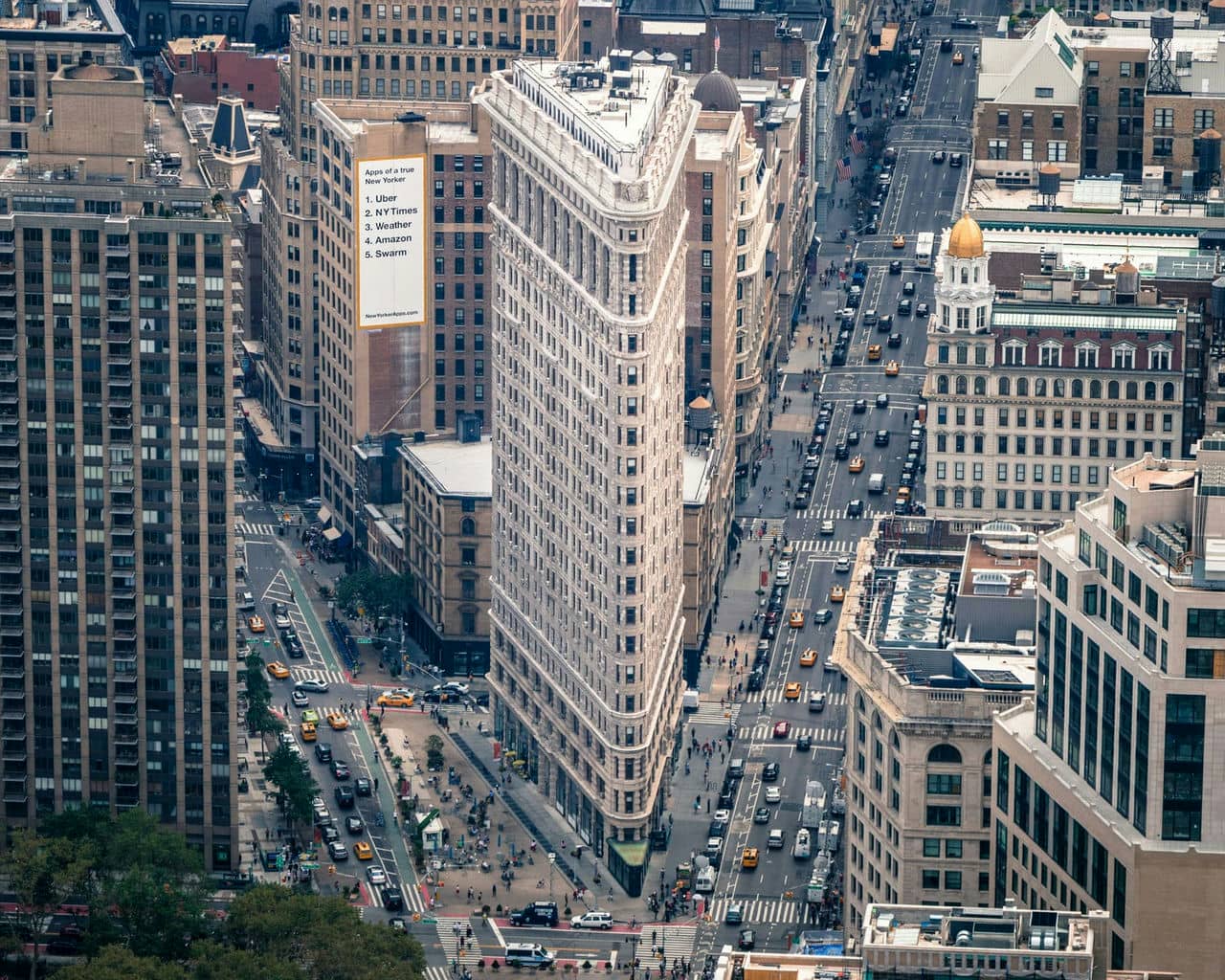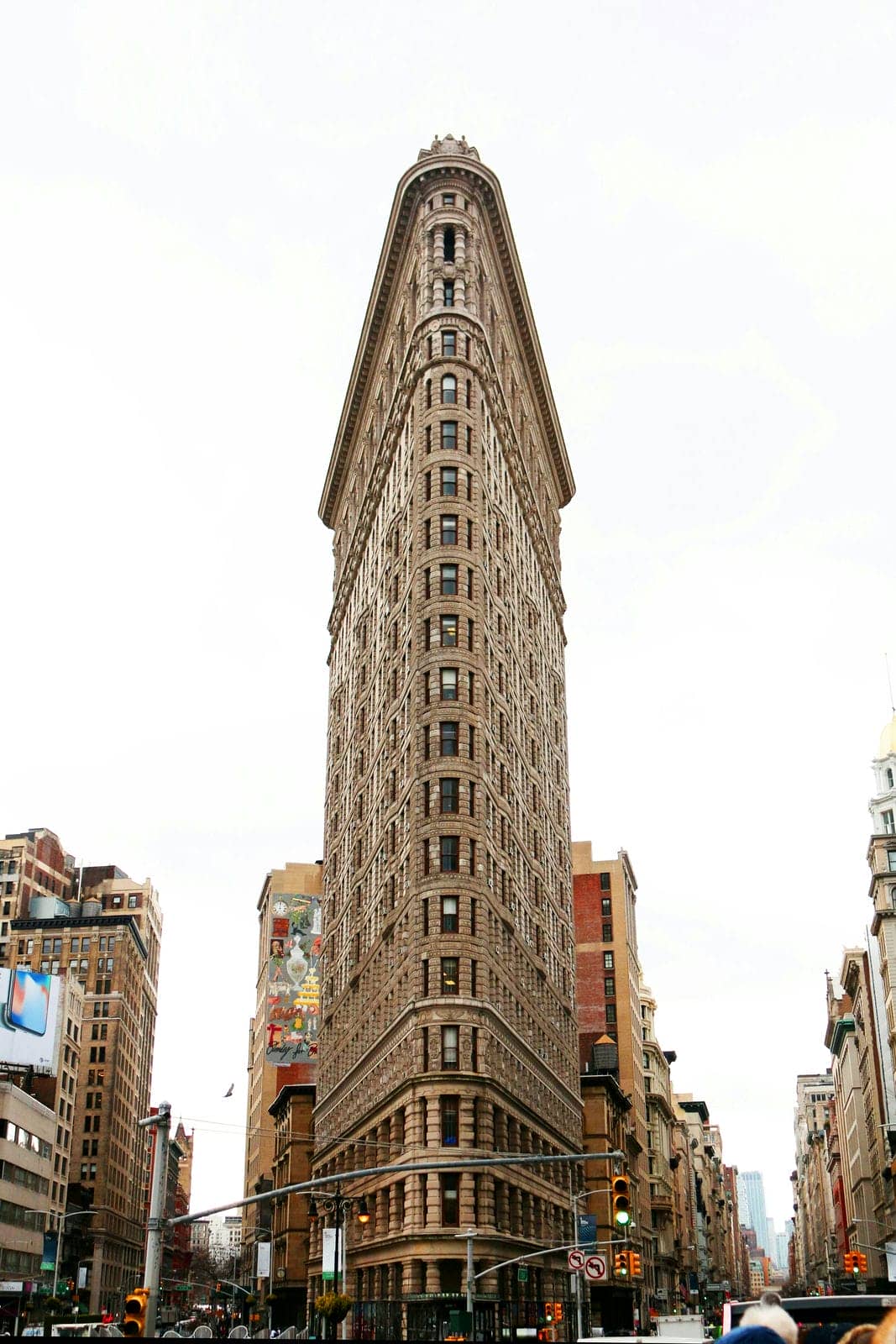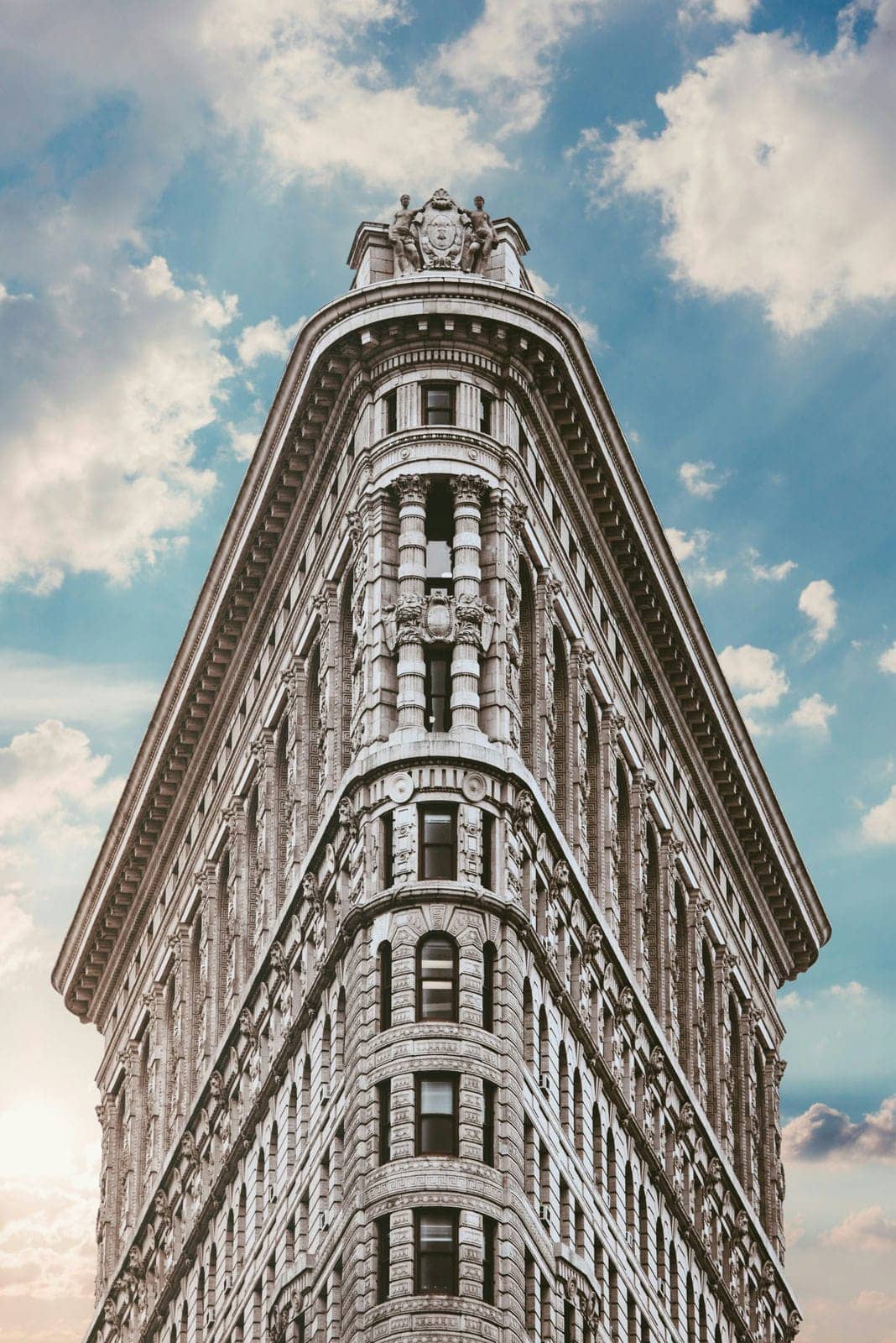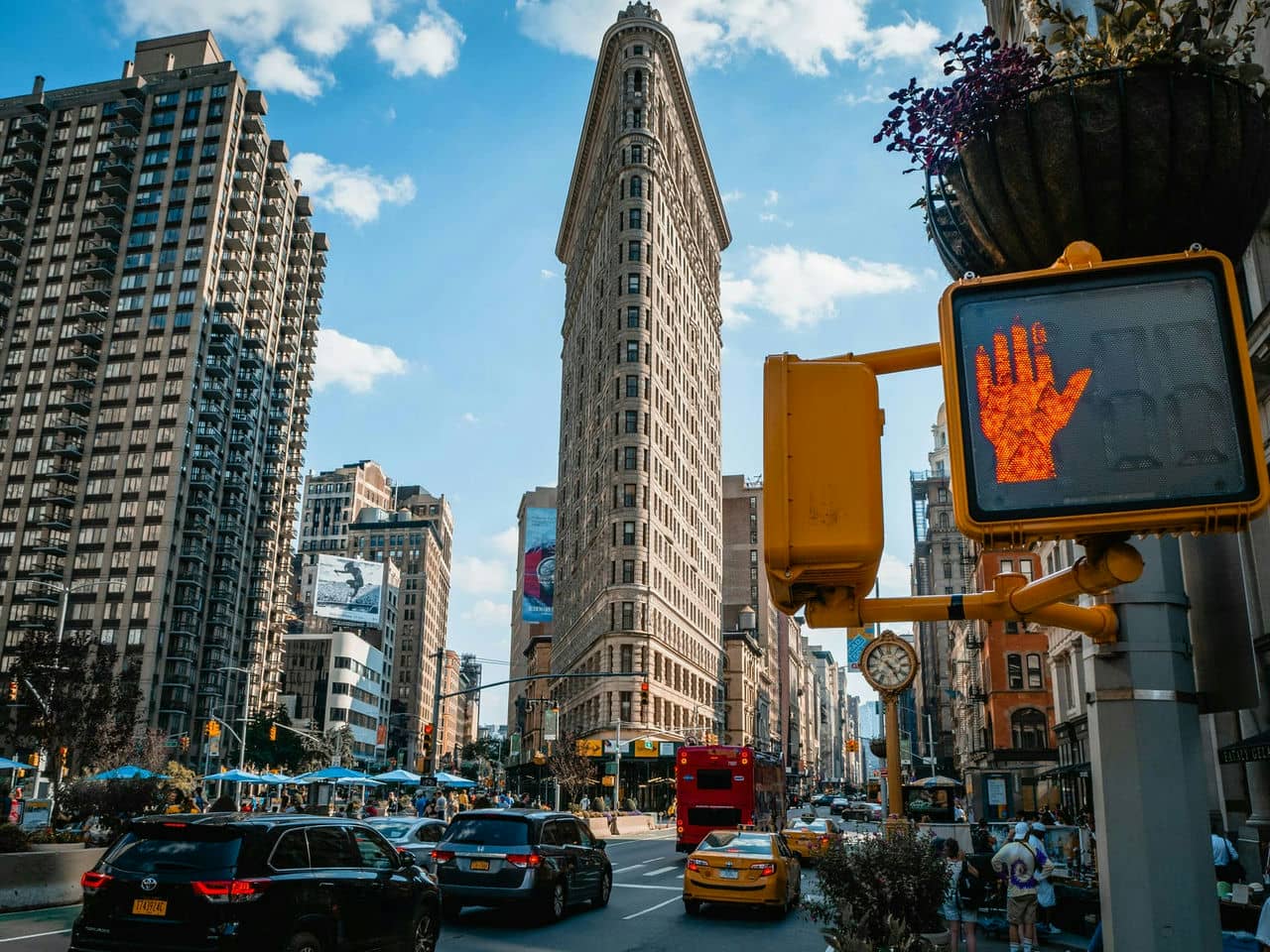The Flatiron Building, situated at 175 Fifth Avenue in Manhattan, is an iconic and distinctive skyscraper that stands as one of New York City’s most recognizable landmarks. Completed in 1902, it was initially known as the Fuller Building, designed in the Beaux-Arts style by the renowned Chicago architect Daniel Burnham. Designed in the Beaux-Arts style, the Flatiron Building features classical Greek and Roman architectural elements, including decorative swags, oval windows, ornate columns, and intricate sculptures. The construction of the Flatiron Building employed several innovative structural engineering principles, including using a steel skeleton frame, making it one of the first skyscrapers in New York City to adopt this technology. The Flatiron Building’s historical design influences are rooted in the Beaux-Arts style, the Chicago School of Architecture, and classical Greek and Renaissance architecture. Originally designed as an office building to establish a new business district, the Flatiron Building’s distinctive shape and ornate design attracted attention and tenants, transforming the surrounding area into a commercial community. The cultural and contextual relevance of the Flatiron Building is evident in its response to the site’s acute angles, its use of classical architectural styles popular in early 20th-century New York, and its representation of the Chicago School’s vision for skyscrapers. The Flatiron Building, an icon of the Chicago School, serves as an architectural landmark that has influenced skyscraper design, construction methods, and zoning laws in New York City. The challenges faced during its ongoing restoration and conversion into residential units include updating systems, preserving historic details, and addressing the building’s narrow footprint and unique shape. Architects can draw valuable lessons from the Flatiron Building’s innovative design solutions, its use of ornate detailing to establish a landmark, and its demonstration of the structural possibilities of new technologies. As one of the best architectural landmarks in the United States, the Flatiron Building stands alongside other notable structures like the Guggenheim Museum, Grand Central Terminal, Seagram Building, and the Empire State Building, showcasing the rich architectural tapestry of the nation.
What is the Flatiron Building?
The Flatiron Building is one of New York City’s most iconic and recognizable skyscrapers. It is located at 175 Fifth Avenue in Manhattan and sits on a triangular block formed by the intersection of Fifth Avenue, Broadway, and East 22nd Street. The Flatiron Building was completed in 1902 and was known as the Fuller Building. Renowned Chicago architect Daniel Burnham designed it in the Beaux-Arts style. The building is considered a groundbreaking skyscraper in construction and design. t 22 stories and 285 feet tall, the Flatiron Building’s most distinctive feature is its narrow triangular shape, resembling a clothes iron. The building’s steel frame allowed it to be constructed relatively easily and quickly for the time. This ornamentation was meant to attract new businesses, transitioning into a commercial district.
The Flatiron Building has become an iconic symbol of New York City. Images of the Flatiron Building now appear on everything from postcards to television shows when referencing New York. The neighborhood surrounding the Flatiron Building is known as the Flatiron District. After mainly sitting vacant for several years, plans were announced in 2023 to convert the building into luxury residential units. This conversion will transform one of New York’s most famous office buildings into sought-after homes. The Flatiron Building continues to be a distinctive architectural landmark, representing the history and innovation of skyscrapers in New York City.

What architectural style is most prominent in the Flatiron Building?
The Flatiron Building is designed in the Beaux-Arts architectural style. It combines classical Greek and Roman architectural elements with ornamentation like decorative swags, oval windows, ornate columns, and sculpture. The most distinctive Beaux-Arts elements of the Flatiron Building are its elaborate terracotta facade, divided into a base, shaft, and capital, and its ornate classical decorative details. The building shaft uses pale brick and terracotta tiles with decorative swags and oval windows. The top floors feature engaged columns, arched windows, a projecting cornice, and a balustrade roofline. These ornamental facade elements and the building’s vertical design resembling a classical column reflect the Beaux-Arts fascination with bold, elaborate, formal aesthetics. The details and Renaissance and Baroque-inspired motifs give the Flatiron grandeur and presence, especially compared to the more austere early skyscrapers of New York. Architect Daniel Burnham embraced the Beaux-Arts style to ensure it would stand out. The prominent Beaux-Arts ornamentation broadcasted the Flatiron Building as a symbol of New York’s architectural ambition and growing prominence at the turn of the 20th century.
What structural engineering principles were employed in the construction of the Flatiron Building?
The Flatiron Building employed several innovative structural engineering principles in its construction. Firstly, the building utilized a steel skeleton frame rather than traditional load-bearing masonry walls to support the structure. This allowed the building to rise to 22 stories and 285 feet (87 meters) in height relatively easily and quickly. The steel frame consisted of over 3,500 tons of steel beams and columns that carried the weight of the building. Secondly, the building’s engineers, Purdy & Henderson, strengthened the narrow steel frame to withstand high wind loads. The Flatiron Building’s triangular shape resulted in a very narrow structure, and the engineers designed the frame to be four times stronger than needed to resist typical wind forces. Lastly, the Flatiron Building was one of the first buildings in New York City to use a curtain wall instead of masonry for fireproofing. The curtain wall hung on the steel frame rather than supporting the building’s weight. This allowed faster construction and more flexibility compared to traditional fireproofed masonry exteriors. The use of a robust steel skeleton frame, wind bracing for the narrow building, and early adoption of curtain wall construction were key structural engineering principles that enabled the iconic Flatiron Building to rise in Manhattan.

Who designed the Flatiron Building?
The Flatiron Building was designed by famous American architect Daniel Burnham, a pioneering Chicago architect and urban planner who helped create the modern skyscraper. Burnham embraced the Chicago School architectural philosophy of tall steel skeleton frames with curtain walls, which allowed the 22-story Flatiron Building to be constructed relatively quickly and economically. He responded to the building’s triangular site at the intersection of Broadway, Fifth Avenue, and 23rd Street by designing the structure as a vertical Renaissance palazzo. The building’s Beaux-Arts limestone and terra-cotta facade features elaborate ornamentation, including oval and arched windows, swags, and columns. This decoration reflected Burnham’s intent for the building to serve as a distinctive landmark to help promote the area as a new business district. The tapered shape rising to a narrow point appeared reminiscent of a flatiron, hence the building’s nickname. Burnham helped make the neoclassical architecture and urban planning ideals movement fashionable in the United States. His Flatiron Building design brought this bold Beaux-Arts aesthetic to the New York City skyline.
What are the historical design influences visible in the Flatiron Building?
The most prominent historical design influences seen in the iconic Flatiron Building are from the Beaux-Arts style, the Chicago School of Architecture, and classical Greek and Renaissance architecture. Firstly, the elaborate ornamentation of the limestone and terracotta facade reflects the Beaux-Arts style popular at the time. Beaux-Arts buildings feature decorative swags, oval windows, columns, and sculptures inspired by French and Italian Renaissance palaces. Daniel Burnham, a leader of the Beaux-Arts movement in America, designed the Flatiron Building. Secondly, the building’s vertical shape and use of a steel skeleton frame epitomizes the Chicago school’s conception of skyscrapers. Burnham and architects like Louis Sullivan pioneered early skyscrapers in Chicago using new technologies like structural steel and elevators. Lastly, Burnham made the building resemble a classical Greek column, with a limestone base, red brick shaft, and elaborate terra-cotta capital. The tripartite division and tapered shape evoke antiquity. The neoclassical details give the modern skyscraper more architectural legitimacy. The design combines cutting-edge skyscraper engineering with historicist architectural styles popular at the time.

How has the Flatiron Building influenced the design of other buildings in New York City?
The iconic Flatiron Building has influenced the design of New York City skyscrapers in several ways. Firstly, the Flatiron demonstrated the viability of the steel skeleton frame in skyscraper design. Many early 20th-century NYC skyscrapers quickly adopted steel framing based on the Flatiron’s success. Secondly, the Flatiron’s distinctive narrow triangular shape influenced skyscraper zoning laws and creative architectural responses to tight urban sites. The 1916 Zoning Resolution imposed setbacks and height limits based partly on concerns about the impacts of slender buildings like the Flatiron. Lastly, the Beaux-Arts terra-cotta ornamentation of the Flatiron façade helped inspire decorated early skyscrapers like the Woolworth Building. Builders were eager to show off intricate architectural detailing even at towering heights, moving away from plain functional designs. This development of skyscrapers as prominent landmarks continues today in contemporary icons like One World Trade Center. The Flatiron Building was influential as one of New York’s first skyscrapers. The Flatiron remains a famous architectural landmark that helped transform early 20th-century perceptions of what skyscrapers could achieve.
What purpose does the Flatiron Building serve, and how does the design help?
The Flatiron Building in New York City was originally designed as an office building to help establish a new business district. Its design took advantage of its small size while maximizing rentable space, visibility, and grandeur. This innovative design provided excellent visibility and a memorable, distinctive shape that drew attention and tenants to the new office building. Burnham further enhanced the Flatiron’s prominence with elaborate Beaux-Arts ornamentation, including swags, oval windows, and columns. The details were meant to evoke classical architecture, providing the modern skyscraper artistic legitimacy while broadcasting its ambition. The building’s iconic architecture almost immediately drew notice and tenants, helping transform Madison Square North into a thriving commercial area.

How is the Flatiron Building maintained?
The iconic Flatiron Building is maintained through regular upkeep. Firstly, basic maintenance involves cleaning and inspecting the limestone and terracotta facade, replacing damaged or worn exterior materials, and keeping the steel skeleton structure intact. Secondly, major renovations occur every few decades to modernize amenities. Recent renovations upgraded systems, restored ornamental detailing, and reconfigured office spaces. The Landmarks Preservation Commission must approve any exterior or structural changes. Lastly, the building’s owners and the Landmarks Commission established special rules, protections, and procedures after its designation as a National Historic Landmark and New York City Landmark. Alterations must not harm historic architectural qualities. Detailed documentation helps guide future work. If neglect threatens the building, the Commission can intervene to compel repairs. The Flatiron Building remains a safe, functional architectural structure, befitting its iconic status in Manhattan.
How does the Flatiron Building reflect cultural and contextual relevance in its design?
The Flatiron Building reflects cultural and contextual relevance in its design in several ways. Firstly, the building’s distinctive narrow triangular shape responds directly to the acute angles of the site at the intersection of Broadway. Secondly, the prominent use of limestone, brick, terracotta, and copper in the ornate Beaux-Arts exterior reflects the classical architectural styles popular in early 20th century New York City. Lastly, Flatiron’s steel skeleton frame represents the Chicago School’s skyscraper engineering, which enabled growth in Manhattan’s dense urban environment. The modern steel and elevator technologies facilitated ever-taller towers to accommodate the city’s development. The Flatiron Building’s design aligned with cultural and contextual trends to become an iconic architectural landmark.

What architectural trend or movement does the Flatiron Building represent?
The Flatiron Building represents the Chicago School of Architecture movement, which pioneered early skyscraper design through structural steel framing and modern construction technologies. This radical approach to skyscraper design was made possible by the Chicago school’s application of new structural steel skeleton framing and curtain wall construction. Burnham and architect Louis Sullivan championed these technologies to enable upward growth by thick, load-bearing masonry walls. The Flatiron dispensed with bulky lower massing, favoring a streamlined tower, maximizing air, light, and invaluable urban real estate. The building represents the Chicago school’s cutting-edge modern vision of skyscrapers. The building epitomizes the school’s defining principles of steel structural frames, elevator circulation, large windows, and restrained ornamentation, allowing facilities to rise to new heights in dense urban centers efficiently.
What are the challenges faced during the restoration of the Flatiron Building?
The Flatiron Building faces several challenges in its ongoing restoration and conversion into residential units. Firstly, the building’s systems need to be updated after 120 years, including elevators, heating, sprinklers, and windows. Upgrading these systems while preserving historic architectural details poses difficulties. Secondly, any changes require extensive review and oversight to meet preservation standards. This adds complexity compared to a standard residential conversion. Lastly, carving out residential units within the narrow building requires creative space planning and moving staircases and elevators. The triangular layout limits the size and forms of units on the upper floors. Thinner spaces also mean less insulation and potential heat loss. Careful restoration work and design will allow the Flatiron to endure as a residential landmark, but the building’s shape and status pose inherent difficulties.
How does Flatiron Building comply with contemporary safety and accessibility standards?
The Flatiron Building faces challenges in complying with modern safety and accessibility standards. Firstly, the building lacks an exterior fire escape, posing safety risks. The cantilevers leave no exterior walls to attach escapes, and the internal stairs connect directly through the building. Upgrades like sprinklers and smoke detectors provide some mitigation, but complete evacuation remains difficult. Secondly, the open-riser stairs and lack of railings create risks. The stairs integrate with the surrounding architecture but violate codes for maximum riser height and lack safety railings aside from a center handrail. This also reduces accessibility for those needing rail support. Lastly, the building’s small footprint, with oddly shaped rooms, complicates renovations to improve access. Upgrading the antique elevators for ADA compliance is difficult without expanding small elevator shafts. Some improvements provide benefits, but significant upgrades face structural and preservation barriers.
Are there any specific tours for architects or architecture enthusiasts visiting the Flatiron Building?
Yes, the Flatiron Building offers several tours for architects, designers, and architecture enthusiasts. The building provides an “Architectural Insight Tour” focused on the design details and history behind one of New York’s most iconic skyscrapers. This 90-minute guided tour allows visitors to explore the distinctive triangular tower inside and out, with stops to closely examine the ornate terracotta facade, steel structural system, and spatial layouts within. Guides discuss the Beaux-Arts architectural style and the influence of architects like Daniel Burnham. For those interested in the creative process behind the innovative design, the Flatiron has a “Designer’s Tour.” This 2-hour tour includes the standard interior viewing and a presentation of Burnham’s original architectural drawings and concept sketches. Participants also walk outside for a better vantage point to understand how the building’s form responds to its unusual site. Additionally, severe architecture and design students can inquire about customized educational group tours to support the architectural curriculum.
What lessons can architects learn from the design and construction of the Flatiron Building?
Architects can learn several key lessons from the iconic Flatiron Building. Firstly, the Flatiron demonstrates innovative design solutions to challenging urban sites. Architect Daniel Burnham responded to the unusual narrow triangular plot by embracing its acute angles to create a distinctive slender tower resembling a classical column. This teaches architects to view restrictive sites as opportunities for inspired form-making. Secondly, the extensive limestone and terra-cotta ornamentation following Beaux-Arts principles shows how elaborate stylistic detailing can establish an architectural landmark. Lastly, the Flatiron reveals the structural possibilities of new skeletal framing and curtain wall technologies to facilitate slender towers. Flatiron Building teaches architects the potential of constraint-based design, the role of facade articulation in creating icons, and the promise of structural innovation to push boundaries.


What are the best architectural landmarks in New York City to visit as an architect?
Listed below are the best architectural landmarks in New York City to visit as an architect:
- Empire State Building: The Empire State Building is a must-visit for architects interested in the evolution of high-rise construction. Designed by Shreve & Lamb and completed in 1931, this iconic structure was once the world’s tallest building. Its distinctive stepped form and steel frame construction represent significant advancements in skyscraper technology. The building’s observation decks provide a unique perspective on New York City’s urban layout, making it not just an architectural icon but also a key vantage point for understanding the city’s development.
- Guggenheim Museum: The Guggenheim Museum by Frank Lloyd Wright is a landmark destination for architects exploring organic architecture. Opened in 1959, its unique spiral structure and continuous ramp challenge traditional museum layouts, offering an uninterrupted journey through the exhibits. Wright’s design philosophy, which sought harmony between the structure and its environment, is demonstrated in the museum’s integration with its urban context. The building’s form and function make it a pivotal study in architectural innovation.
- Chrysler Building: The Chrysler Building is an architectural symbol of the Art Deco era, making it an essential visit for architects studying this design movement. Completed in 1930 and designed by William Van Alen, its distinctive stainless steel crown and spire showcase exquisite decorative artistry. The building’s interior, especially its lobby, reflects the opulence of the late 1920s and early 1930s. It stands as a testament to the era’s architectural creativity and the technological advancements in skyscraper design.
- The High Line: The High Line is an outstanding example of urban regeneration and landscape architecture, offering architects insights into innovative urban design and public space revitalization. Transformed from an elevated freight rail line into a public park by Diller Scofidio + Renfro and James Corner, it blends horticulture, art, and design within a dense urban context. This project demonstrates the potential of adaptive reuse in urban environments and the integration of green spaces within cityscapes.
- One World Trade Center: One World Trade Center is a significant architectural site for architects interested in skyscraper design and urban resilience. Completed in 2014 and designed by David Childs of Skidmore, Owings & Merrill, it stands as a symbol of rebirth on the site of the original Twin Towers. The building features advanced safety and sustainability elements, making it a modern architectural marvel. Its design respects the site’s history while marking a new era in high-rise construction.
- Flatiron Building: The Flatiron Building is an architectural icon and a pioneering skyscraper in New York City, significant for architects studying early 20th-century urban architecture. Completed in 1902 and designed by Daniel Burnham, its unique triangular shape and Renaissance Revival style were innovative for its time. The building’s slender profile and distinct facade have made it a symbol of New York’s architectural heritage, offering insights into the city’s architectural evolution.
- Brooklyn Bridge: As one of the oldest suspension bridges in the United States, the Brooklyn Bridge is a landmark of engineering and architecture. Completed in 1883 and designed by John Augustus Roebling, it connects Manhattan and Brooklyn across the East River. The bridge’s Gothic-style stone towers and intricate cable arrangement make it a study in both aesthetic beauty and structural ingenuity. For architects, it represents a significant moment in the history of bridge design and urban connectivity.
- Seagram Building: The Seagram Building, designed by Ludwig Mies van der Rohe and Philip Johnson, is a fundamental site for architects interested in modernist architecture. Completed in 1958, this skyscraper is celebrated for its functional aesthetics and adherence to the ‘less is more’ philosophy. Its use of high-quality materials, like bronze and travertine, and the concept of the elevated plaza as an urban space, have influenced subsequent office building designs. The building exemplifies the International Style and has had a lasting impact on corporate architecture.


